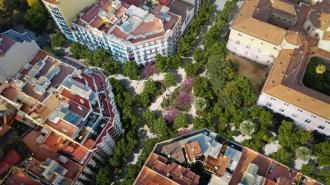Under its new “superblocks” plan, Barcelona has set out several groups of 3×3 city blocks where car traffic inside is mostly banned, and spaces for parks, pedestrians, and cyclists are expanded. A new study is exploring how the same approach could be applied in cities around the world — without becoming too inconvenient for car traffic.
Urban superblocks: Modern cities are faced with a daunting array of challenges: flooding, air and noise pollution, extreme heat. For urban planners, these issues are throwing up important questions about how our cities can become more liveable, sustainable, and resilient against climate change.
One innovative plan is currently being rolled out in Barcelona, Spain’s second largest city. Many of Barcelona’s streets are arranged in a grid, and under the plan, 3×3 groups of blocks have been merged into “superblocks.” While the streets surrounding the superblocks remain open to car traffic, the streets inside can’t be crossed by car, and impose speed limits of just 10 to 20 km per hour to make it safe for pedestrians.
This transformation means that much of the space occupied by these streets can now be dedicated to walking, cycling, and public transport. The plan also opens up room for new parks and green spaces, introducing corridors of biodiversity that traverse the city.
In superblocks, car traffic is mostly banned, and spaces for parks, pedestrians, and cyclists are expanded.
On top of this, superblocks can act as their own independent communities: allowing residents to easily walk to local shops, schools, and restaurants, without dodging traffic or queueing at corner crosswalks.
Barcelona now has a long-term vision to introduce superblocks across the entire city. One study in 2020 suggested that if around 500 superblocks were created, the reduction in heat and pollution experienced by local residents could increase their average life expectancy by almost 200 days.
Until now, it’s been difficult for city planners to weigh the pros and cons of superblock and miniblock rollouts.
The challenge: Despite the optimism of this vision, the plan hasn’t come without opposition. For some residents and city planners, the concern is that superblocks could cause severe disruption to car traffic. This will not only make life harder for people who need to drive, it could also raise congestion and pollution in the streets surrounding superblocks.
As a compromise, some urban planners have suggested “miniblocks” as a potential solution. Made of 2×2 or 1×2 groups of city blocks, miniblocks follow the same logic as superblocks, but present less of an obstacle to the car traffic flowing around them. Still, there is a concern that miniblocks wouldn’t provide the same benefits to walkability and sustainability as superblocks.
Until now, no system has been created for weighing up the pros and cons of superblock and miniblock rollouts. So far, this has made it difficult for urban planners to come up with solutions that can please everyone.
The study: In a new analysis, Sven Eggimann at Empa, Switzerland, has developed a method for evaluating the potential for superblock transformations in different cities. The automated system works by considering how the ability of people to move around the city would change when superblocks and miniblocks are placed in different locations.
Driven by real data collected from these cities, Eggimann’s system could calculate how (mostly) banning traffic in one area affects the rest of the street network. Besides Barcelona, he also considered several other global cities, with widely varying shapes and sizes.
In Tokyo, Paris, and Cairo, more than 20% of streets could be designated as superblocks.
Although Barcelona’s square grid street network has provided an ideal model for testing the superblock concept, the results showed that the idea can also be well suited to cities with highly irregular street networks.
In some cities, such as Atlanta, Eggimann found that just a small percentage of streets would be suitable for superblock placement, before becoming majorly inconvenient for car traffic. This was mainly due to their low population densities. In contrast, over 40% of streets in Mexico City could be designated as superblocks, provided they are placed in suitable locations. In cities including Tokyo, Paris, and Cairo, this number still exceeded 20%.
Miniblocks widely followed the same pattern in Eggimann’s calculations – but in cities like London, they could be far more appropriate. Here, the potential for superblocks is comparatively low, since they would often be intersected by roads which are important arteries for car traffic. As a result, miniblocks could provide a well-suited compromise.
The system could help cities become more resilient against climate change, while increasing locals’ happiness.
The big picture: Altogether, Eggimann’s results provide the first detailed look at how Barcelona’s innovative approach to urban design could be applied in cities with diversely varied cultures and urban layouts – many of which will face their own unique set of challenges in the coming decades.
By providing urban planners with useful guidance as to where superblocks and miniblocks can realistically be placed, Eggimann hopes that his system will allow cities around the world will become more sustainable and resilient against climate change; while also becoming happier, healthier, and safer places for people to live.
We’d love to hear from you! If you have a comment about this article or if you have a tip for a future Freethink story, please email us at tips@freethink.com.
